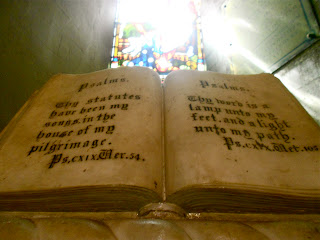Today was our first full day in Dublin. We departed for
Trinity College Dublin at 9 AM to go see a well-known exhibit at the
university’s library, called the Book of Kells. The Book of Kells is a lavish
Celtic copy of the gospels that dates back about 1,000 years. During this time,
the Irish church was largely monastic in organization. Monks traveled to remote
places, like the Aran Islands, to fulfill their religious duties of prayer,
manual labor, and manuscript writing. The Book of Kells was written by the
monks of Iona, off the west coast of Scotland, but sent to Trinity when Vikings
raided the monastery in 806 A.D.
We then toured the city by foot, visiting some coffee shops
dedicated to famous Irish writers and poets, as well as the famously colorful
Dublin doors. When Queen Victoria of England died in the early 1900’s, the
English wanted everyone to paint their doors black as a sign of grief. The
Irish, of course, painted their doors as colorful as they could to demonstrate their
independence from the British monarchy.
Our next excursion was to St. Patrick’s Cathedral. This
cathedral is perhaps one of the most important to Ireland because St. Patrick
himself is said to be perhaps the biggest reason for social and religious cohesion
in Ireland – Ireland being predominantly Roman Catholic. The oldest part of the
cathedral, the baptistery, dates back to around 1190 A.D., where St. Patrick
baptized converts to Christianity. Being in the cathedral itself made me think
of something Kelly said yesterday about King Phillips XIII of England, who sent
in his men to convert all Catholics in Ireland to Protestants. King Phillips XIII himself was a Catholic who
converted to Protestantism in order to not be ruled by a church, so that he
could obtain Ireland and other neighboring lands. He imposed laws upon the
Irish that would benefit all Protestants but critically hurt Catholics, such as
taxes on all goods, a limitation on livestock, and the prohibition of selling
their harvest, while Protestants enjoyed all their rights. Although it called for a nearly impossible life, there was much
protest to converting within Ireland, which is one of the contributing factors
to Ireland’s persistently large Catholic population.
We had free time for the rest of the day, so a smaller group
of friends and I headed to the Guinness distillery. The Guiness distillery was
about 8 floors high with the Gravity Bar at the top, which had all glass walls
so we could see the entire city of Dublin. We learned a lot about the history of
Guiness, which begun in 1759 with a bold Irish man named Arthur Guinness. It was interesting
to not only see how the beer (“baere” in Galic, meaning “barley”) was made, but
how much of a trademark it is for Ireland. We then took a horse and buggy to
the Jameson distillery for a shorter tour. Ashley and Jill got to taste-test Jameson (Irish), Johnnie Walker (Scottish), and Jack Daniels (American) whiskeys. We learned about the company since
it’s founding in the 1800’s by John Jameson and the triple distillation
process, which sets Jameson apart from whiskeys like Johnnie Walker and Jack
Daniels because it is distilled a total of three times, compared to twice (Scotch) and even just once (American whiskey).

No comments:
Post a Comment